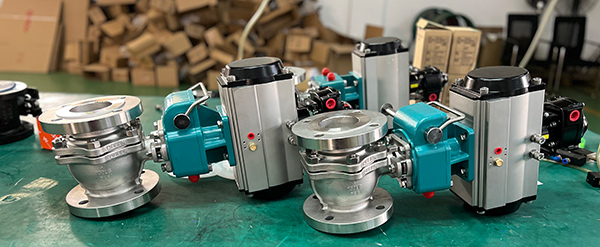
When you have trouble with a pneumatic ball valve, you want fast and sure fixes. Good troubleshooting keeps your plant safe and working. You keep your system safe by acting quickly and using the right steps.
- Quick shut-off in emergencies can stop leaks and keep your plant safe.
- Self-checking features warn you about problems before they get worse.
- Strong parts and safe designs help stop dangerous failures.
- Good actuator work makes every ball valve and actuator in your system safer.
POV VALVE is a trusted brand for both pneumatic and electric ball valve solutions. Use this guide to fix problems fast and keep your valves working for a long time.
Key Takeaways
- Always follow safety steps before you work on pneumatic ball valves. This keeps you and your plant safe. Check for leaks, rust, and loose parts often. This helps you find problems early and keeps valves working well. Use clean, dry air at the right pressure. This makes the valve work smoothly and stops it from getting stuck or slow. Look at actuators, solenoids, and electrical parts often. Take care of them to stop valve failures and downtime.
Pneumatic Ball Valve Basics

What Is a Pneumatic Ball Valve
A pneumatic ball valve is a type of valve that uses compressed air to control the flow of liquids or gases. You will find that this valve has a round ball inside. The ball has a hole through the middle. When you turn the ball, the hole lines up with the pipe, and fluid can flow. When you turn the ball again, the hole turns away from the pipe, and the flow stops. The pneumatic actuator uses air pressure to move the ball quickly and with little effort from you. This makes the pneumatic ball valve a good choice for systems that need fast and reliable control.
Here is a table showing the main parts and their roles:
| Component | Description / Material | Function / Role in Operation |
|---|---|---|
| Valve Body | Stainless steel, carbon steel, alloy | Holds the ball and seats; connects to pipeline |
| Ball | Stainless steel, brass | Rotates to control flow |
| Valve Seat | PTFE or corrosion-resistant materials | Makes a tight seal |
| Pneumatic Actuator | Metal housing, internal piston | Uses air to turn the ball |
| Stem & Seals | Metal rod and sealing rings | Connects actuator to ball; stops leaks |
| Manual Override | Mechanical lever | Lets you operate the valve by hand |
How It Works
You control a pneumatic ball valve by sending compressed air into the actuator. The actuator changes the air pressure into rotary motion. This motion turns the stem and the ball inside the valve. The ball rotates 90 degrees to open or close the flow. Most pneumatic actuated ball valves use a rack and pinion system. The rack moves in a straight line when air pushes the piston. The pinion, which is a round gear, turns as the rack moves. This action rotates the ball valve and lets you start or stop the flow.
Here is a simple step-by-step process:
- Compressed air enters the actuator.
- The piston moves because of the air pressure.
- The rack and pinion system turns the valve stem.
- The ball rotates 90 degrees.
- The valve opens or closes, depending on the ball’s position.
Solenoid valves help control the air supply. They let you set the exact position of the pneumatic operated ball valve. Some air actuated valves have a manual override. This feature lets you move the valve by hand if the air system fails.
Typical Uses
You will see pneumatic ball valves in many industries. These valves work well in places where you need fast, safe, and reliable flow control. Here are some common uses:
- Chemical plants use pneumatic ball valves to handle dangerous fluids safely.
- Water and wastewater treatment plants use them for quick and easy flow control.
- Oil and gas pipelines rely on these valves for high-pressure fluid movement.
- Food and beverage factories use them for clean and precise flow control.
- HVAC systems use air actuated ball valves to manage air flow.
Pneumatic actuated ball valves are popular because they work fast and last a long time. You can use them in systems that need many open and close cycles each day. They are also a good choice when you want to control the valve from a distance. If you need a valve that can handle tough jobs and keep your plant safe, a pneumatic ball valve is a smart option.
Tip: Always choose the right ball valve and actuator for your system. This helps you avoid problems and keeps your process running smoothly.
Pre-Troubleshooting Steps
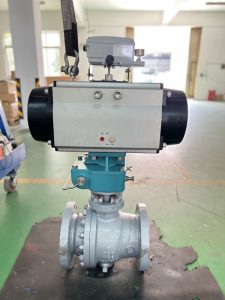
Safety First
You must be careful before fixing a pneumatic ball valve. Safety steps keep you and your tools safe. Always use lockout/tagout to stop all energy. Turn off the power and put on locks or tags. This stops anyone from turning it back on by accident. Next, let out all the air pressure. Open the valve or use the maker’s way to release air. Never skip this step. Trapped air can move parts fast and hurt you.
Clean around the valve before you start. Take away any trash or things in the way. Make sure you have good light and space to work. Only trained people should work on pneumatic actuated ball valve systems. Check your tools to see if they work right. Always wear the right PPE for the job. If you work in a small space, follow special rules. You may need a permit and to test the air. Make emergency plans before you begin any troubleshooting.
Here is a table to help you remember the main safety protocols:
| Safety Protocol | Description |
|---|---|
| Lockout/Tagout (LOTO) | Isolate energy sources and use locks/tags to stop accidental reactivation. |
| Depressurization | Release all air pressure using safe methods. |
| PPE | Wear gloves, goggles, and other gear for protection. |
| Area Preparation | Clean the workspace and make sure it is well-lit and easy to access. |
| Emergency Preparedness | Know what to do if something goes wrong during troubleshooting. |
Tip: Always check that the pneumatic operated ball valve is fully off before you start.
Initial Checks
Begin by looking closely at the valve and its parts. A visual check helps you find problems early. Look for rust, damage, or wear on the valve body and actuator. Check all air connections for leaks. Spray soapy water on joints and fittings. If you see bubbles, there is a leak.
Make sure bolts and hardware are tight. Loose parts can make the air actuated ball valve work badly. Look at tubing and hoses for holes, bends, or tears. Change any broken parts right away. Watch how the actuator moves when you use the valve. If it moves slow or uneven, there may be a problem inside.
You can also use leak tests like bubble testing or pressure decay to find leaks you cannot see. If you have an infrared camera, look for hot spots. Hot spots can mean seal problems or not enough oil. These tips help you find trouble before it gets worse.
Note: If you need help, POV VALVE gives support for all ball valve and actuator systems.
Tools Needed
You need the right tools to fix problems well. Get these things before you start:
- Adjustable wrenches and screwdrivers
- Soapy water spray bottle for finding leaks
- Torque wrench for bolts
- New seals, O-rings, and oil
- Flashlight or work light
- Multimeter for checking wires (if your air actuated valve uses solenoids)
- Infrared thermometer (optional, for extra checks)
- PPE like gloves and safety glasses
Having these tools ready saves time and keeps you safe. Always use real parts from POV VALVE when you change seals or other parts. This helps your pneumatic ball valve work better and last longer.
Tip: Keep a troubleshooting checklist with you. It helps you follow each step and not miss anything important.
Common Pneumatic Actuated Ball Valve Problems

Pneumatic ball valves are important in many industries. Sometimes, these valves have problems that can make your system unsafe or not work well. If you know how to find and fix these problems, your plant will run better.
Solenoid Valve Sticking
A solenoid valve controls air for your pneumatic actuated ball valve. If the solenoid valve sticks, the ball valve might not move. This can happen because of dirt, rust, or bad wires. Small bits of dirt can block the moving parts inside the solenoid. Rust from water or chemicals can also make it stick. Bad wires or broken coils can stop the solenoid from working.
To fix this, look at the solenoid for dirt or rust. Listen for a click when you turn on the coil. If you do not hear a click, check the wires with a multimeter. Clean or change the solenoid if it is broken. Cleaning and checking for rust often can stop this problem.
Valve Won’t Open or Close
Sometimes, the ball valve will not open or close. This is a very common problem. There are a few reasons why this can happen.
Air Supply
Your pneumatic operated ball valve needs clean air at the right pressure. If the air is dirty or the pressure is too low, the valve may not move. Leaky air lines, blocked filters, or bad regulators can cause leaks. You might hear a hiss or see bubbles if you spray soapy water on the fittings. Pressure gauges can show if the air pressure drops. Tighten loose parts and change broken tubes to stop leaks. Checking and cleaning air lines often can stop many problems.
Electrical Issues
Bad wires can stop your air actuated valve from working. Problems with solenoid valves, limit switches, or control circuits can make the ball valve get stuck. Look for loose wires, blown fuses, or broken relays. Use a multimeter to check the voltage at the solenoid and switches. Change broken parts right away. Keeping wires and parts in good shape helps stop problems.
Mechanical Blockage
Dirt, rust, or old parts can block the ball inside the valve. If you cannot shut off the ball valve, look for dirt or buildup inside. Rust can make the ball or seats stick. Take the valve apart if you need to and clean all the parts. Change any old or broken seals. Using rust-proof parts and cleaning often can stop this problem.
Leaks
Leaks are a very common problem in pneumatic systems. Leaks can waste fluid, lower pressure, and break equipment.
External Leaks
External leaks happen when fluid comes out of the valve or its parts. Old seals, loose parts, or cracked tubes can cause leaks. You can find leaks by looking for wet spots or puddles near the valve. Use soapy water to find small leaks. Listen for hissing sounds that mean air is escaping. Tighten parts and change broken seals to fix leaks. Checking seals and parts often can help stop leaks.
Internal Leaks
Internal leaks happen when the ball valve cannot seal tightly. Broken seat seals, O-rings, or gaskets are common causes. If the ball is not lined up right or is damaged, it can also leak. You may see that the valve cannot shut off all the way. To check, look for cracks or damage on the seats and seals. Pressure tests and watching the valve work can help you find leaks inside. Change old or broken parts to make the seal work again. Checking often and using good parts helps your ball valve and actuator last longer.
Tip: Check your pneumatic ball valve system often to find problems early. This keeps your system safe and working well.
Actuator Issues
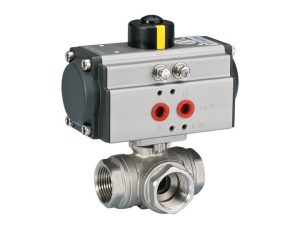
When you work with a pneumatic ball valve, you may face problems with the actuator. The actuator is the part that moves the ball inside the valve. If the actuator does not work right, the whole system can stop. Here are some common actuator issues you might see with a pneumatic actuated ball valve.
No Response
Sometimes, you may notice that the actuator does not move at all. This problem can happen for several reasons:
- The air supply may not reach the actuator.
- The control signal may not get to the actuator.
- The actuator itself may have a broken part.
To check for this issue, listen for air movement when you send a signal. If you hear nothing, look at the air lines and fittings. Make sure the air pressure is correct. Use a multimeter to check the electrical signal if your system uses a solenoid. If you find a broken part, replace it with a genuine part from POV VALVE.
Tip: Always check the air supply and control signal first. These are the most common causes of actuator problems.
Slow or Erratic
You may see the actuator move slowly or in a jerky way. This can make the pneumatic operated ball valve open or close at the wrong speed. Common causes include:
- Low air pressure in the system.
- Dirty or clogged air filters.
- Sticky or worn internal parts.
Check the air pressure gauge. If the pressure is low, look for leaks or blockages. Clean or replace air filters if they look dirty. Lubricate moving parts if needed. If the actuator still moves slowly, you may need to rebuild or replace it.
Actuator Air Leaks
Air leaks in the actuator can cause big problems for your air actuated valve. Leaks waste air and lower the pressure needed to move the valve. You can find leaks by listening for hissing sounds or using soapy water on joints and seals. Common leak points include:
- Worn O-rings or seals.
- Loose fittings.
- Cracked actuator housings.
If you find a leak, tighten the fittings or replace the damaged seals. Always use the right O-rings and seals for your actuating valve. Using quality parts from POV VALVE helps prevent leaks and keeps your ball valve and actuator working well.
Sticking or Partial Movement
A pneumatic actuated ball valve may not move all the way open or closed. This is a sign of sticking or partial movement. Here are the main causes:
Debris
Dirt or small particles can get inside the valve or actuator. This debris can block the ball or stem. You may notice the air actuated ball valve feels hard to turn or stops partway. Clean the valve and actuator to remove any debris. Use clean air to blow out dust and dirt.
Corrosion
Corrosion happens when water or chemicals attack metal parts. Rust can make the ball or stem stick. You may see red or brown spots on the valve. Replace corroded parts and use corrosion-resistant materials for longer life.
Misalignment
If the actuator and valve do not line up, the ball may not turn right. Misalignment can happen after repairs or if the valve gets bumped. Check the mounting brackets and bolts. Make sure everything lines up before you use the pneumatic operated ball valve again.
Seat Seal Damage
The seat seal keeps the valve tight when closed. If the seal is worn, cracked, or deformed, the valve may leak or not close fully. Inspect the seat for damage. Replace it if you see wear or breakdown. Using the right seat material helps prevent common ball valve issues.
Note: Regular checks and using quality parts help you avoid most problems with your pneumatic ball valve system.
Troubleshooting Pneumatic Operated Ball Valve Problems
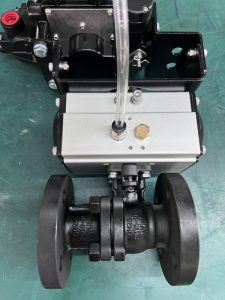
Air Leaks
Air leaks are a very common problem in pneumatic systems. If your valve does not work well or you hear hissing, there may be a leak. You can use these easy steps to find and fix air leaks in your pneumatic operated ball valve:
- Check all joints and connections. Spray soapy water on them. Bubbles show where air is leaking.
- Use the right tools to tighten any loose clamps or fittings.
- Change old seals or O-rings. Pick the right size and type. Add oil when putting in new parts.
- Look at hoses and tubes for holes, bends, or cuts. Replace any broken ones right away.
- Put thread sealant or Teflon tape on threads to help stop leaks.
- Turn off the system and let out all air before working on the valve.
- Take the valve apart and look for dirt or dust inside. Clean out anything that blocks air.
- Use gentle cleaners and compressed air to clean the valve.
- Check inline air filters and change them if they are clogged.
- Put the valve back together. Make sure everything is tight but not too tight.
- Test the valve to see if it works and check again for leaks.
- Look at the pressure regulator and change it if needed.
- Check the air compressor to make sure it gives enough pressure.
- Look at flow control valves and fittings for blockages or wrong settings.
- Test different parts of the system to find where pressure drops.
- Change worn parts like actuators, diaphragms, or springs if needed.
Tip: Always use real POV VALVE parts for repairs. This helps you fix ball valves fast and keeps your pneumatic actuated ball valve system working well.
If you follow these tips, you can fix most air leaks. Good troubleshooting keeps your air actuated valve working and stops bigger problems.
Pressure Issues
Pressure problems can make your pneumatic operated ball valve work badly or stop. You need to keep air pressure in the right range for the valve and actuator. Most pneumatic actuated ball valves need 60-100 PSIG. If the pressure is too high or low, you may see slow movement, the valve not opening all the way, or not closing.
- Always look at the pressure gauge. Make sure you read the units right. PSIG is not the same as PSIA.
- Using the wrong units can break the valve or cause leaks. For example, a factory had a pipe burst because they mixed up PSIG and PSIA.
- Label all gauges clearly and watch both PSIG and PSIA if you can. This helps you find pressure problems early.
- If you see pressure drops, look for leaks, blockages, or a bad air compressor.
- Test the pressure regulator and change it if needed.
- Check the flow control valves and make sure they are set right.
You can use these steps to keep your pneumatic ball valve system safe and working well. Watching the system in real time helps you find problems before they stop your work.
Electrical and Signal Checks
Electrical and signal problems can stop your pneumatic operated ball valve from working. The valve may move slowly, not move, or move in a jerky way. Here are some common problems and ways to fix them:
- Solenoid coil damage or burnout happens a lot. Too much heat, bad air flow, or wrong placement can burn the solenoid. If the valve does not work, check the solenoid first.
- Low voltage can make the valve slow or act strange. Use a multimeter to check the voltage at the solenoid and control panel.
- Electrical noise from other machines can mess up the valve. Move cables away from big machines if you see problems.
- Power supply and wiring problems can stop the valve from moving. Look for loose wires, blown fuses, or broken relays.
- Positioner problems can make the valve move wrong or not at all. Calibration drift, old parts, or dirt can cause this. Check the input signal and air lines for leaks or blocks.
- Air quality and pressure also affect signals and how the actuator works.
Note: If you cannot find the problem, call POV VALVE for help and new parts. Their team can help you fix valves and solve hard ball valve problems.
Fixing electrical and signal problems helps you avoid downtime and keeps your pneumatic actuated ball valve system working. Always use these steps to keep your system safe and reliable.
Mechanical Damage
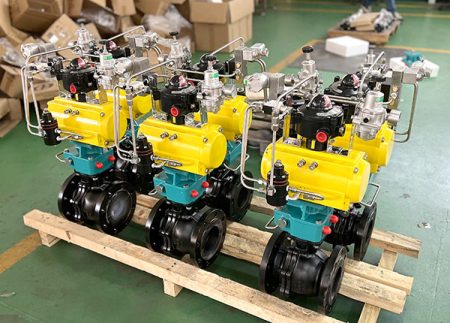
Mechanical damage can stop your pneumatic ball valve from working. You might see dents, cracks, or worn parts on the valve body or actuator. These problems often happen after impacts, over-tightening, or long use. If you see any damage, you need to act fast to keep your system safe.
Start by looking at the outside of the pneumatic operated ball valve. Check for bent stems, broken handles, or cracked housings. Use a flashlight to see small cracks or chips. If you find any, do not use the valve until you fix or replace the damaged part.
Next, take off the actuator if you need to check inside. Look for scratches or grooves on the ball or seats. These marks can stop the ball from sealing. If you see metal shavings or dust, clean them out. Replace any parts that look worn or broken.
Here is a simple checklist for finding mechanical damage:
- Inspect the valve body for dents or cracks.
- Check the actuator for loose or broken parts.
- Look at the stem and seals for wear.
- Examine the ball and seats for scratches or chips.
- Remove any debris or metal shavings.
Tip: Always use genuine POV VALVE parts when you replace damaged pieces. This helps prevent future ball valve problems and keeps your pneumatic actuated ball valve working longer.
If you find damage, do not try to fix it with glue or tape. Replace the part or the whole valve if needed. Using damaged parts can cause leaks or sudden failures. Good troubleshooting methods help you spot these issues early and avoid bigger problems.
Positioner and Feedback
The positioner and feedback system help you control your air actuated valve with precision. The positioner tells the actuator how far to turn the ball. The feedback system lets you know if the valve is open, closed, or in between. If these parts do not work, your pneumatic ball valve may not move as you expect.
First, check the positioner for loose wires or air lines. Make sure the mounting bolts are tight. If the valve does not reach the right position, the positioner may need calibration. Follow the maker’s guide to reset or adjust it.
Next, look at the feedback switches or sensors. These parts send signals to your control system. If you get wrong readings, check for dirt, loose wires, or broken sensors. Clean the sensors and tighten the wires. Replace any sensor that does not work.
You can use this table to help with positioner and feedback checks:
| Step | What to Check | What to Do if Problem Found |
|---|---|---|
| Positioner | Loose wires, air leaks | Tighten or replace as needed |
| Calibration | Wrong valve position | Follow calibration steps |
| Feedback Sensors | Dirt, loose wires, damage | Clean, tighten, or replace sensors |
| Signal Test | No or wrong signal | Use a multimeter to test |
Note: If you cannot fix the problem, contact POV VALVE for technical support or replacement parts. Their team can help you solve even the hardest ball valve problems.
Regular checks of the positioner and feedback system help you avoid unexpected shutdowns. Keeping these parts in good shape ensures your pneumatic operated ball valve responds quickly and accurately.
Preventing Common Air Actuated Ball Valve Issues
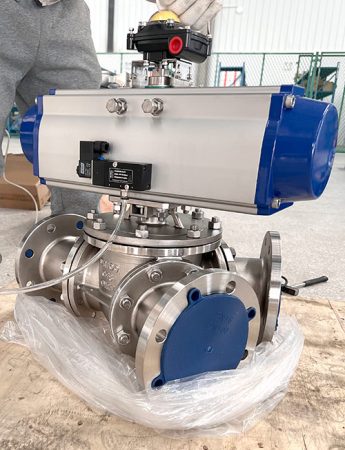
Regular Maintenance
You can stop most problems by doing regular maintenance. Checking your valves often helps you find trouble before it gets worse. Look at your pneumatic ball valve, pneumatic actuated ball valve, and pneumatic operated ball valve at least once a year. If your system works under high pressure or is used a lot, check it more often.
Some important things to do are:
- Look at the valve body, actuator, and connections for leaks or rust.
- Make sure all bolts and hardware are tight.
- Test if the air actuated valve and position indicators work right.
- Check seals, O-rings, and rubber parts for damage.
- Change old or worn parts during yearly shutdowns.
Follow the maker’s rules and your plant’s needs for your maintenance plan. Finding leaks or worn parts early saves money and stops surprise shutdowns. Always use safety gear when working on ball valves. Using covers and pressure tests also helps keep your equipment safe.
Tip: Write down every inspection and repair in a log. This helps you remember what you did for each ball valve and actuator.
Cleaning and Lubrication
Cleaning and adding oil are important for ball valve care. Dirt and dust can get inside your air actuated ball valve. This can make it stick, leak, or need more force to move. Clean your valves at least once a year, or more if your plant is dusty.
Here are some cleaning steps:
- Wipe the valve body with a clean cloth.
- Use a wire brush on moving parts if needed.
- Pick cleaners that are safe for the valve material. Use gas or compressed air for metal valves. Use alcohol or water-based cleaners for non-metal parts.
Adding oil helps your pneumatic operated ball valve move easily. Use synthetic, water-resistant, oil-based oils. Do not use clay or solid oils because they can block the valve. Oil all moving parts and seals to stop wear and help the seal.
Cleaning and oiling your valves often helps you find problems early. These steps help your air actuated valve last longer and cost less to fix.
| Maintenance Task | Frequency | Notes |
|---|---|---|
| Cleaning | Annually or more | Clean more if your plant is dirty |
| Lubrication | Annually or as needed | Use the right synthetic oil |
| Inspection | Annually or more | Look for leaks, rust, and worn parts |
Air Quality
Clean air is very important for your pneumatic ball valve and pneumatic actuated ball valve. Dirty air can make parts wear out fast, leak, or stick. Watch your air system for dust, oil, and water. Put in air filters and dryers to keep the air clean.
Keeping air clean helps your air actuated valve work well. Bad air makes common ball valve problems and shortens the life of your equipment. Check and change air filters often. Make sure your compressor and air lines stay dry and free of dirt.
Note: Clean air keeps every ball valve and actuator in your plant safe. Good air means fewer repairs and longer use.
Proper Installation
Putting in your valve the right way is very important. This helps stop common ball valve issues before they start. When you install a pneumatic ball valve or air actuated valve, you help keep things safe. If you skip steps or hurry, you might get leaks or other problems. The valve could break sooner than it should.
Always follow the manufacturer’s instructions for your pneumatic actuated ball valve. Each type might need special steps. Read the manual before you begin. Gather all your tools and parts first. Make sure you have the right size and kind of ball valve and actuator for your job.
Important steps
- Inspect all parts
Look at the pneumatic operated ball valve, actuator, and fittings. Check for damage or missing pieces. - Clean the pipeline
Take out dirt and dust from the pipes. Clean pipes help keep the actuating valve safe. - Align the valve and actuator
Put the ball valve and actuator in the right spot. The stem must line up with the actuator. If not, the valve might stick or leak. - Tighten bolts and fittings
Use a torque wrench to tighten bolts just right. Do not make them too tight. Too much force can hurt the seals or crack the valve. - Check for correct air supply
Hook up the air lines to the air actuated valve. Make sure the air pressure is right for the valve. Use clean, dry air to protect the system. - Test the system
Open and close the pneumatic ball valve a few times. Listen for odd sounds. Watch for leaks or slow movement. Fix any problems before using the valve for real.
Tip: Always use the right gaskets and O-rings for your pneumatic operated ball valve. Wrong parts can cause leaks and other common ball valve issues.
Here is a table to help you remember the main installation checks:
| Step | What to Do | Why It Matters |
|---|---|---|
| Inspect Parts | Check for damage or missing items | Stops early failure |
| Clean Pipeline | Remove debris | Keeps blockages and wear away |
| Align Components | Line up valve and actuator | Stops sticking and leaks |
| Tighten Properly | Use correct torque | Protects seals and valve body |
| Air Supply Check | Match pressure and quality | Makes sure things work smoothly |
| System Test | Operate valve before use | Finds problems early |
When to Replace Your Ball Valve

Signs of Failure
It is important to know when your ball valve is worn out. Some signs mean you should get a new one soon. If you see these problems, act fast to keep your system safe.
- Leaks that do not stop, even after you change seals or O-rings
- Bad rust on the valve body or actuator
- The valve keeps getting stuck or will not open or close all the way
- Cracks or dents in the valve’s outside
- Strange sounds or shaking when the valve works
- You lose pressure or cannot control flow, even after fixing it
These problems are signs of common ball valve failure. If you notice them, it is safer to replace the valve than keep fixing it. A broken pneumatic ball valve or pneumatic actuated ball valve can stop your work and cause safety problems.
Tip: Write down every repair in a log. If you see the same problem many times, it means you need a new ball valve and actuator.
Choosing a Replacement
Picking the right new ball valve is very important for your plant. The new valve must fit your system’s needs. Here are the main things to think about:
1. Pressure and temperature: The valve must handle your system’s limits. 2. Port size: Pick full port or standard port for your flow. 3. Manual or automatic: Choose a handle or an actuator. 4. End connections: Get threaded, flanged, or socket weld for your pipes. 5. Flow control: Use a valve with modulating features if you need to change flow. 6. Body and inside parts: Pick stainless steel, brass, or other materials for your media. 7. Maintenance: Choose a valve that is easy to fix. 8. Space and size: Make sure the valve fits where you want to put it. 9. Cost and value: Balance price with how long it will last and how much it costs to fix. 10. Leak protection: Pick a valve that seals well for safe use.
Also, think about what will flow through the valve, how you will move it, and how often you will use it. For a pneumatic operated ball valve or air actuated valve, check the actuator type and control system. Always pick a valve that matches your job and keeps things safe.
Upgrading with POV VALVE
Getting a POV VALVE pneumatic ball valve gives your plant many good things. You get better work, less downtime, and more value over time.
| Performance Improvement | Description |
|---|---|
| Enhanced Reliability | Strong design keeps it safe from shaking, pressure changes, and heat. |
| Minimal Maintenance | Easy to reach parts means less time fixing and fewer stops. |
| Cost-Effectiveness | Lower price at first and saves money later because parts last longer. |
| Reduced Noise and Vibration | Quiet and smooth running makes things safer and more comfortable. |
| Precise and Rapid Control | Fast and accurate flow control with pneumatic actuation. |
| Customization Flexibility | Many choices for different media, temperatures, and extras. |
| Improved Performance Over Time | Greasing often helps the valve work better for a longer time. |
When you pick a POV VALVE pneumatic actuated ball valve or air actuated ball valve, you get a strong product for hard jobs. You can count on it to shut off well and be easy to fix. This upgrade helps you avoid common ball valve failure and keeps your plant working well.
- Always think about safety first when you fix a pneumatic ball valve or pneumatic actuated ball valve.
- Follow simple steps: look for leaks, check the seals, and see if the actuator moves right.
- Clean and oil your pneumatic operated ball valve or air actuated valve. Change any parts that look old or broken.
- Do regular checkups to stop problems before they start and help your actuating valve last longer.
- Use real parts for your ball valve and actuator so they work their best.
If you need help, ask POV VALVE for advice. With good support, you can keep your plant working well and avoid shutdowns.
FAQ
What is the difference between a pneumatic ball valve and a pneumatic actuated ball valve?
A pneumatic ball valve uses air to move the ball inside. A pneumatic actuated ball valve means the valve has an actuator attached. The actuator uses air to open or close the valve for you.
How do you know if your pneumatic operated ball valve has a leak?
You can spray soapy water on the valve and look for bubbles. Listen for hissing sounds. If you see or hear these signs, your pneumatic operated ball valve may have a leak.
Why does my air actuated ball valve move slowly?
Low air pressure, dirty air, or clogged filters can slow your air actuated ball valve. Check the air supply and clean the filters. Make sure the actuator gets enough clean air.

Can you repair an actuating valve, or should you replace it?
You can repair an actuating valve if the problem is small, like a worn seal. If you see cracks, heavy rust, or repeated failures, you should replace the valve and actuator for safety.
Which industries use pneumatic ball valves the most?
You will find pneumatic ball valves in chemical plants, water treatment, oil and gas, food factories, and HVAC systems. These valves work well where you need fast and safe flow control.
Tip: Always use the right parts for your pneumatic actuated ball valve. This keeps your system safe and working longer.
